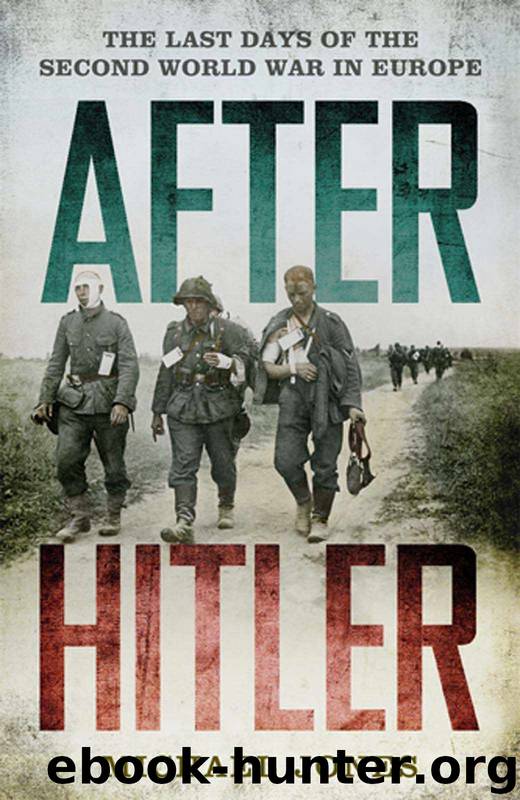After Hitler by Jones Michael

Author:Jones, Michael
Language: eng
Format: epub
Publisher: Hodder & Stoughton
Published: 2015-01-14T16:00:00+00:00
7
The Dispossessed
6 May 1945
ON 6 MAY MAJOR Hugh McLaren of the 10th British Casualty Clearing Station arrived at Sandbostel concentration camp in northern Germany, 35 miles north-east of Bremen. He wrote a memoir of his experiences, describing it as a ‘horror camp’. Horror is not, perhaps, the most original word for the events of the time – the vast human displacement all over Europe, the death marches, the liberation of slave labourers and the uncovering of the Nazi policy of annihilating those considered undesirable to their new order – but it remains an apt description.
Allied troops who liberated the concentration and extermination camps were profoundly shocked and disturbed by what they encountered. The medical staff who accompanied or followed them had to then stay in these camps and attempt to transform the conditions there. McLaren knew, at the time of his posting, that Sandbostel had been liberated by the British troops of XXX Corps a week earlier, on 29 April. Fighting was still going on and in the immediate aftermath of liberation resources were scarce. But in his first four days at the camp he was absolutely overwhelmed by what he encountered.
‘My first view of Sandbostel was somehow what I had expected,’ McLaren began. ‘Miles of wire encircled each low hut, a further wire fence enclosing the whole compound. There were watch towers equipped with searchlights and machine guns were placed around the perimeter to cover all eleven exits. It was an ugly place to look at – but when you entered the main part of the camp you realized that it was built in a saucer shaped depression giving the prisoners a view of nothing but the sky and the wire wall.’
Already McLaren was encountering a sense of alienation and deprivation. But he then described the camp in more detail: ‘The standard hut was about forty yards long, each having a dark central corridor. In the hospital where we worked, twenty small rooms led off the corridor. In the prisoner section, however, each hut was designed like a barn. There were a dozen shelves where the prisoners could lie down in close-packed rows; an occasional foul mattress was seen, but for the most part the prisoners lay on bare wooden shelves. There were between forty and sixty of them on each long wooden shelf. The most chaotic slum dwelling on the Clydeside was luxurious in comparison.’
Sandbostel camp consisted of three sections. The first was for POWs from the Western Allies. Here conditions were basic. The second was for Russian prisoners. Here conditions were poor. The third was for political prisoners. Conditions here were appalling. It was this section which McLaren would be serving as a doctor. He was totally sickened by his first visit to the hospital. Each hut was crammed with about 350 patients. The latrines had been blocked for days. Most were too weak to rise from their beds. These skeletal patients – naked, unshaved and dirty – defecated where they stood or lay. In one of the huts six were found to be dead.
Download
This site does not store any files on its server. We only index and link to content provided by other sites. Please contact the content providers to delete copyright contents if any and email us, we'll remove relevant links or contents immediately.
The Radium Girls by Kate Moore(10914)
The Templars by Dan Jones(4192)
100 Deadly Skills by Clint Emerson(4084)
Rise and Kill First by Ronen Bergman(4017)
The Doomsday Machine by Daniel Ellsberg(3736)
The Rape of Nanking by Iris Chang(3525)
Killing England by Bill O'Reilly(3459)
Hitler in Los Angeles by Steven J. Ross(3444)
Stalin by Stephen Kotkin(3089)
12 Strong by Doug Stanton(3059)
Hitler's Monsters by Eric Kurlander(2736)
Darkest Hour by Anthony McCarten(2650)
Blood and Sand by Alex Von Tunzelmann(2611)
The Art of War Visualized by Jessica Hagy(2416)
Hitler's Flying Saucers: A Guide to German Flying Discs of the Second World War by Stevens Henry(2298)
The Code Book by Simon Singh(2215)
The Second World Wars by Victor Davis Hanson(2136)
Babylon's Ark by Lawrence Anthony(2073)
Tobruk by Peter Fitzsimons(2064)
